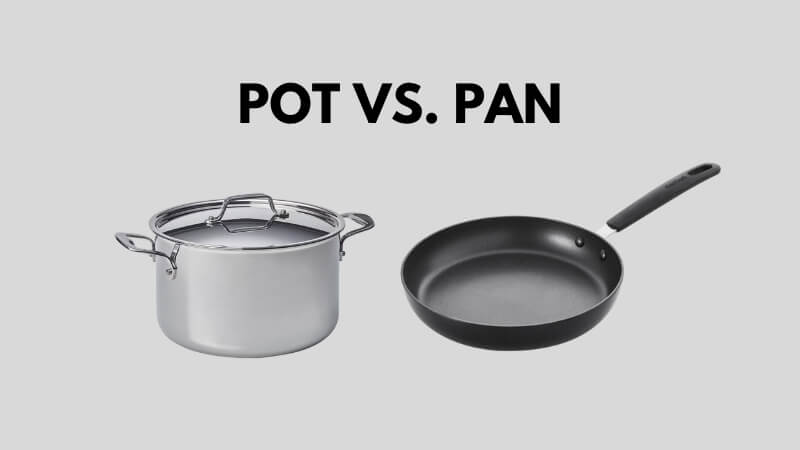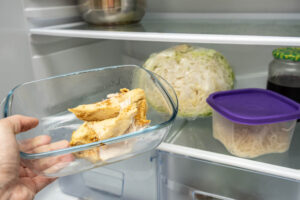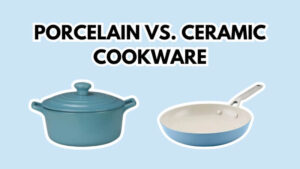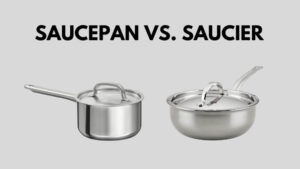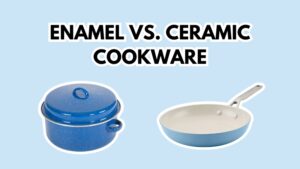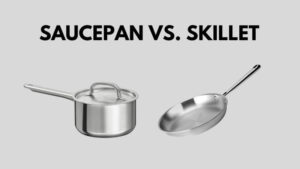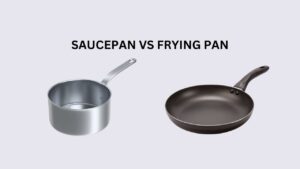Pans and pots are both kitchen staples. However, their designs and functions are tailored to distinct cooking techniques. Whether you’re searing, frying, boiling, or simmering, knowing when to use a pan or a pot can improve your results. Let’s break down the pan vs pot differences so you can confidently tackle your next recipe.
Key Differences of Pan vs Pot
Design
Pans feature a flat cooking surface with sides that can be straight or slightly sloped, depending on the type. Their shallow design is excellent for tasks such as frying, searing, or sautéing. In contrast, pots are deeper with vertical or slightly flared walls that provide a larger capacity for holding liquids. This makes them better for boiling, simmering, and slow cooking, where ingredients need to be submerged.
Pans typically have a single long handle, making them easy to maneuver while cooking. This is useful for tasks like tossing ingredients while sautéing or transferring the pan from the stovetop to the oven. Pots, however, have two sturdy handles on either side, designed to help with lifting and carrying the heavier weight of their contents.
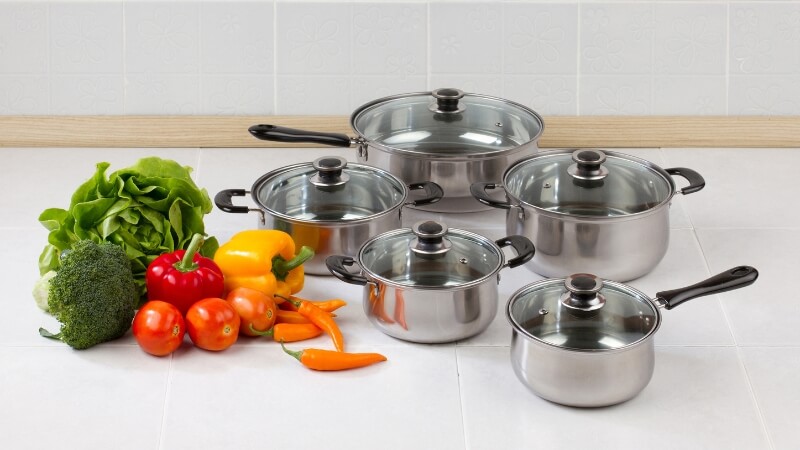
Primary uses, pot vs pan cooking
A pan’s flat base provides an even cooking surface, which is ideal for high-heat cooking. For example, if you’re sautéing vegetables, frying eggs, or searing meats, a pan is your go-to. Its design allows you to achieve a crispy, golden crust when browning meat or preparing delicate items like fish fillets.
Pans are also great for grilling and toasting, such as making grilled sandwiches, pancakes, or tortillas. Because of their open structure, pans allow liquids to evaporate quickly. They are perfect for reducing sauces or glazes. Additionally, pots offer greater versatility for dishes that transition from stovetop to oven, such as frittatas or baked chicken breasts.
In contrast, pots are meant for cooking tasks that involve liquids or require longer cooking times. Their deep walls and larger capacity make them fantastic for boiling, simmering, or slow cooking. With that said, if you’re preparing pasta, rice, or grains, a pot is the better option. Pots are also great for making soups, stews, or large batches of chili and curry.
Their design retains heat effectively, making them ideal for slow-cooked dishes like braised meats or hearty sauces. The deep, enclosed space of a pot makes it perfect for steaming vegetables or dumplings, trapping steam inside for even cooking.
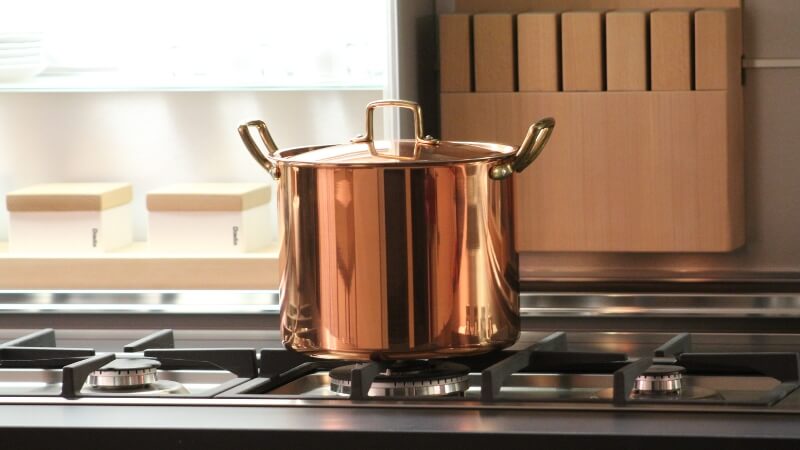
Cooking techniques for Choosing the Right Pan or Pot
Selecting the right cookware isn’t just about design, it’s about how it performs in different cooking techniques. Here are my suggestions how to choose the best pan or pot for your next dishes:
- Searing and browning: Cast iron skillet or stainless steel pan (locks in flavor and creates a perfect crust).
- Sautéing and stir-frying: Stainless steel cookware vs nonstick sauté pan (allows food to move freely).
- Boiling and simmering: Stock pot (ideal for large volumes of liquid like pasta or soups).
- Slow cooking and braising: Dutch oven (maintains low, consistent heat for hours).
- Steaming and poaching: Saucepan vs saucepot (gentle cooking without direct heat).
Types of Pans
Frying pan
A pan with low sides and a flat base. It is typically used for frying, sautéing, and searing. A frying pan is perfect for cooking eggs, bacon, or stir-frying vegetables. Many frying pans are made from cast iron or non-stick materials, which makes cooking and cleaning easier.
Sauté pan
Similar to a frying pan but with slightly higher, straight sides, a sauté pan is ideal for cooking with a bit more liquid or when you need to toss food around. It is most commonly used for searing meat, making sauces, or cooking dishes that need to be stirred frequently.
Grill pan
A pan with raised ridges like a grill. It is perfect for achieving those BBQ grill marks and a smoky flavor without an actual outdoor grill. Grill pans are great for cooking meats, vegetables, or fish indoors, with grilled textures and appearances.
Wok
A deep, round-bottomed pan. The wok is particularly great for stir-frying, steaming, and braising. Its shape allows for quick, high-heat cooking, where ingredients are rapidly tossed and cooked evenly.
Types of Pots
Stock pot
A large, deep pot designed for making stocks, broths, soups, or large batches of pasta. It typically has a wide base for easy stirring and can hold a substantial amount of liquid. Stock pots often come with a lid to retain heat and moisture during long cooking processes.
Sauce pot
A smaller, more versatile pot used for making sauces, gravies, or heating liquids. It is ideal for cooking smaller batches and offers a comfortable size for simmering without the need for a large stock pot.
Dutch oven
A heavy, thick-walled pot, often made from cast iron and sometimes enamel-coated. It is perfect for slow cooking, braising, baking, and making stews. Dutch ovens are rather versatile and can go from stovetop to oven, so they are excellent for dishes like pot roast or bread.
Pressure cooker
A sealed pot that speeds up cooking by trapping steam and regulating internal pressure through a controlled release valve. It is fantastic for making tender meats, beans, and stews in a fraction of the time compared to traditional methods.
When selecting between a pan vs pot, ask yourself what do I cook most often? If you frequently fry or sear foods, a frying pan or sauté pan will be essential. If you often prepare soups or stews, a stock pot or Dutch oven will serve you well. Large pots and pans are particularly useful for cooking for a crowd or handling larger quantities of food.
How Many Pots and Pans Do I Need?
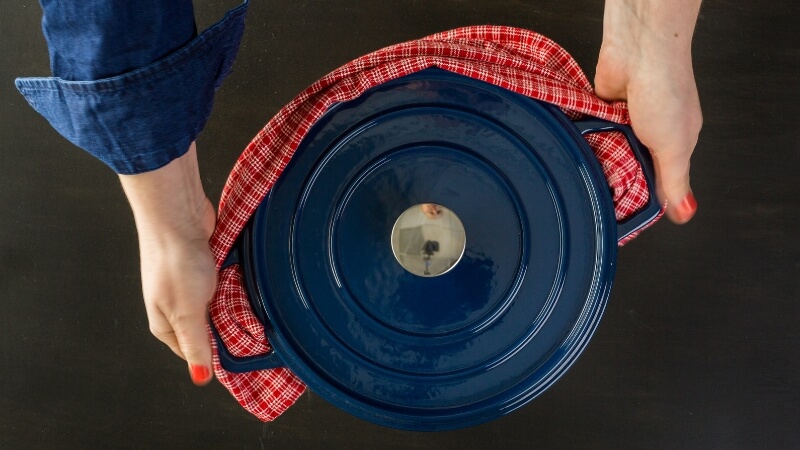
It depends largely on your cooking habits, space, and the type of meals you prepare. While it is easy to get overwhelmed by the wide variety of cookware available, you don’t need to have every type of pot and pan to create a well-rounded kitchen setup. Instead, focus on selecting a few essential pieces that will cover most of your cooking needs.
At a minimum, most kitchens can get by with a frying pan, saucepan, and stock pot. If you cook a lot or enjoy preparing a variety of dishes, you might want to expand your collection with a grill pan, wok, and Dutch oven.
How Much Do Pots and Pans Cost?
The cost of pots and pans can vary widely depending on factors such as material, brand, size, and the type of cookware. If you’re just starting out or cooking on a budget, you can find quality pots and pans at lower price points. Inexpensive options are often made from materials like aluminum.
Mid-range options offer a good balance between price and performance. At this price point, you can expect better materials such as heavier-duty stainless steel. For those who prioritize craftsmanship, longevity, and performance, high-end pots and pans can be worth investing in. These often come from well-established brands and are made from premium materials.
Ultimately, the amount you spend will depend on your cooking habits, the quality you desire, and how much you’re willing to invest.
Conclusion
Understanding the key pan vs pot differences can significantly impact your kitchen efficiency and the quality of your meals. Pans are excellent for frying, searing, and sautéing, while pots are excellent for boiling, simmering, and slow cooking. Both have their place in the kitchen, but make sure you select the one that fits your needs and makes cooking more enjoyable and efficient.

